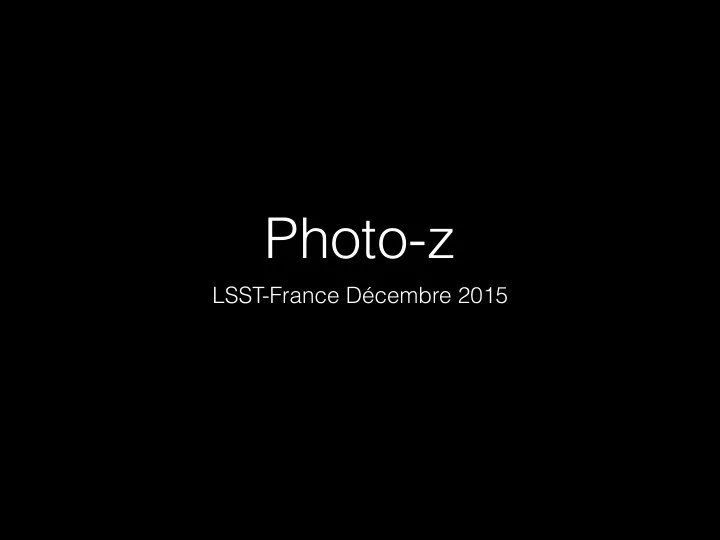

Photo-z LSST-France Décembre 2015
Photo-z is the key to LSST Science Goals LSST Specs : bias < 0.003, RMS < 0.05 2 main methods: Machine learning -> non-completeness bias Template fiting -> need SED library Home made TF PZ code developed in LPSC (Gorecki/Ricol) Same logic as LePhare, less features (extinction laws, 0-point correction …)
SED library Needed for simulation (+LF/MF) and template fitting pz z + galaxy characteristics (mass, SFR, age …) Priority in DESC PZ WG CWW&K, Poletta, Brown, Fors2 (see E. Nuss presentation) + simulation (BC/Gissel/Starlight) z(Brown)<0.05, z(Fors2)<1.05 CFHTLS + LePhare : CWWK > Fors2 > Brown Candels-goods + LPSC PZ code : CWWK=Brown >> Fors2
Continuous library Continuous color distribution, smooth PDF(T) Select few representative SEDs (CWWK) —> interpole them PCA : scatter the eigenvalues to produce « continuous » templates Problems with negative flux Is a linear distribution in eigenvector space more meaningful than in the real space ?
Continuous library SOM : 2D representation of a ndim space where each cell represents 1 vector, neighboring cells have similar parameters see for instance Master et al arXiv:1509.03318 SOM BMU w/ CWWK First tentative on Cosmos->LSST catalog (LePhare) Can point a lack of SEDs, useful to map extinction … Can it be used to build a library ?
Spectro-photo catalogs • Candels_goods 14 bands, 1169 galaxies, z=[0, 4.5], <z>=1.7 see my talk in Montpellier • CFHTLens 5 bands, ~26000 galaxies, z=[0, 4.5], <z>=0.7 see Cécile Rousselle's presentation • COSMOS 30 bands, 4296 galaxies (2009), z=[0,3], <z>~1 more bands => more constraints on SEDs —> we can also use a LSST-like catalog from COSMOS- LePhare data
LePhare Emission lines Kennicut 1998 log ( F [OII] ) = − 0 . 4 × M UV + 10 . 65 − DM ( z ) 2 . 5 OIII, Hb, Ha, Lya from OII 21 SEDs 3 extinction models : - LePrevot et al if redder than SB3 - Calzetti et al (+ 2175A° UV bump) if bluer
LePhare performances on COSMOS
Other activities z = 0.5 0.01 Filters study : impact of slopes, bias • 0.008 bandwidth mis-calibration, spatial 0.006 0.004 inhomogeneities … on pz 0.002 See Adeline Choyer PhD thesis 0 -0.002 (LSST note / article in progress) Reference -0.004 -+-+-+1nm -+-+-+0.5nm -0.006 -+-+-+0.2nm +-+-+-0.2nm -0.008 +-+-+-0.5nm +-+-+-1nm -0.01 All El Sbc Scd Irr SB3 SB2 • BDT / LR tool to remove outliers : 5 10 BDT 100% cut see Gorecki et al 2014 BDT 90% cut BDT 80% cut 4 10 Will soon be tested on COSMOS- BDT 60% cut 3 LePhare P(z) (O. Ilbert) 10 2 10 10 1 -1 -0.8 -0.6 -0.4 -0.2 0 0.2 0.4 0.6 0.8 1 z ∆
Other activities • Photo-z and atmosphere : use Y effective filter (airmass) to (try to) improve photo-z performances, under progress • Extinction law(s) : in principle extinction law should be a free parameter in the fit (hyperz) Chevalard et al 2013 predict a quasi-universal relation between slope of the attenuation curves and V-band attenuation optical depth at all galaxy inclinations —> this should simplify the dust treatment PhD thesis proposed in LAM
PZ codes • If the C++ version is developer- friendly we will likely use LePhare • Compare performances with other codes • P(z) combination (Carrasco-Kind) • ML/TF : - cross analysis to tag outliers CFHTLS - LF built with ML (low z) - ML trained with LF (high z)
Conclusion • Photo-z is (one of) the key to LSST science • OCEVU : started collaboration with LePhare experts • We must increase french contribution
Recommend
More recommend